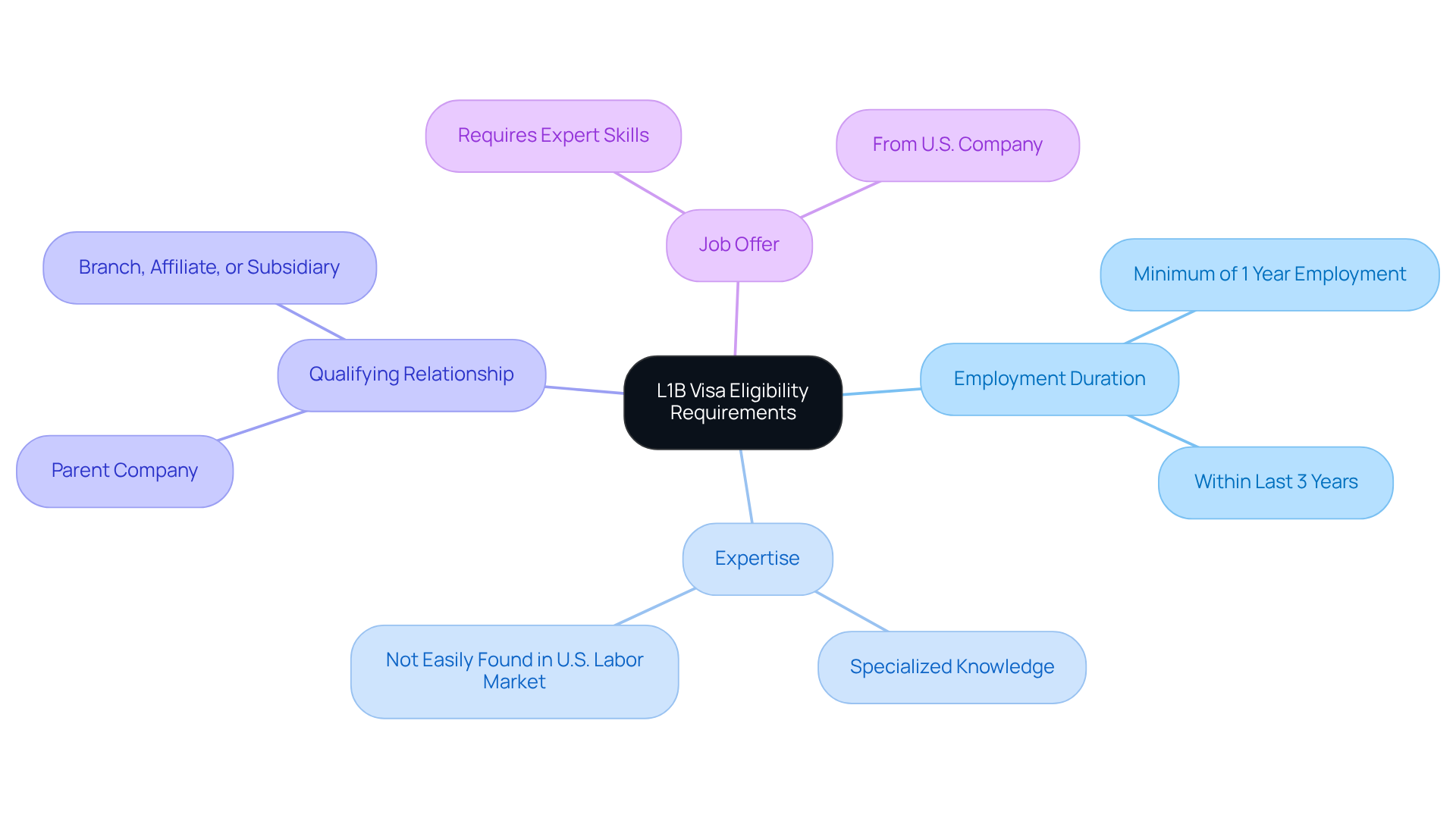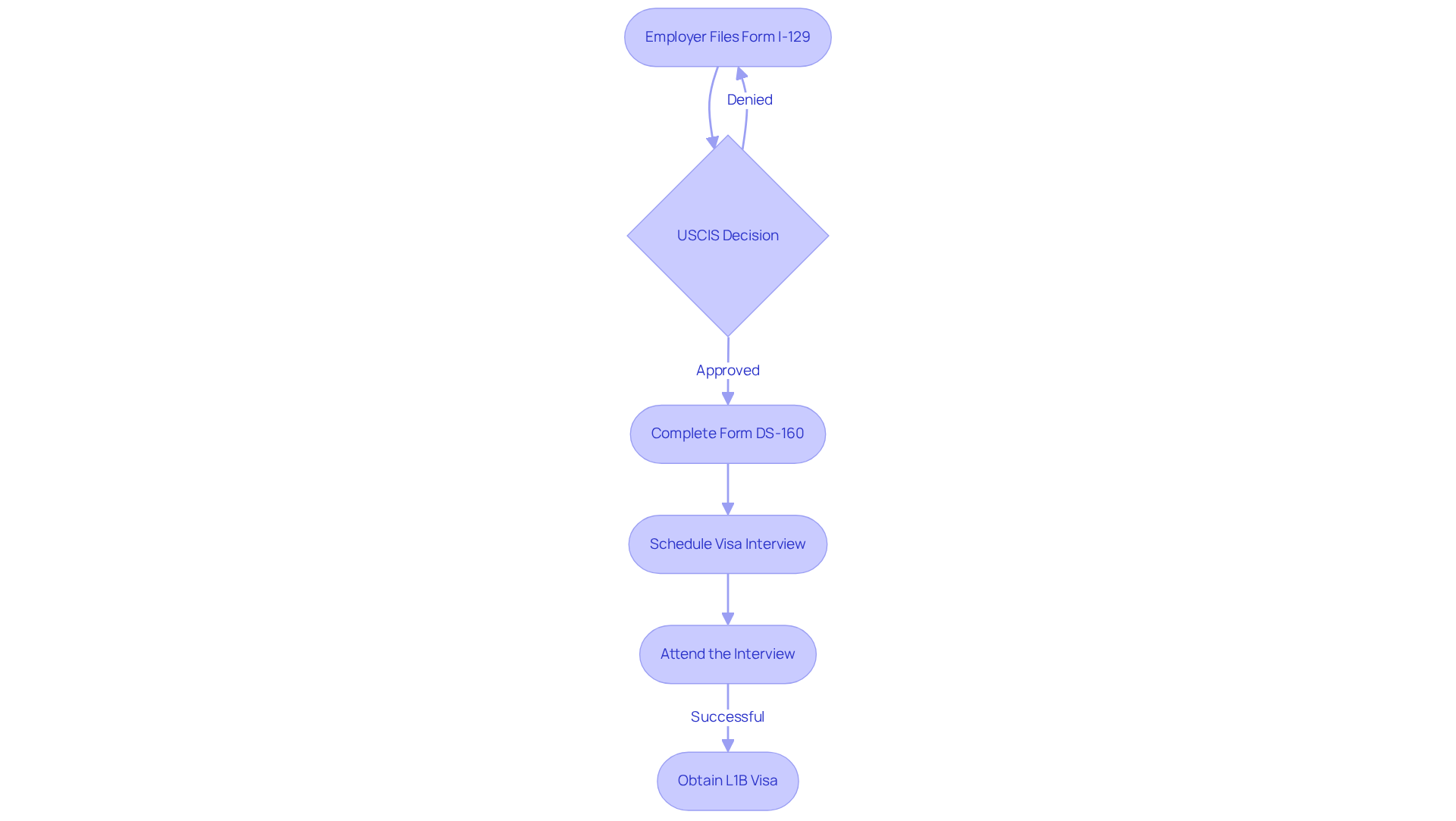Overview
The L1B visa process is crucial for U.S. employers looking to transfer skilled workers with specialized knowledge from foreign offices to their U.S. branches. However, this journey can feel overwhelming, with specific eligibility criteria and a detailed application process to navigate. This article outlines the process step-by-step, highlighting the importance of thorough documentation and preparation.
By addressing common challenges head-on, we aim to empower qualified candidates, ensuring a higher likelihood of approval. Remember, you don’t have to face this alone; we’re here to fight for you every step of the way.
Introduction
Navigating the complexities of the U.S. immigration system can feel overwhelming, especially when dealing with specialized work visas like the L1B. This visa category not only enables the transfer of skilled professionals from foreign offices to U.S. branches but also significantly enhances the competitive edge of global corporations. As approval rates for L1B applications increase, so do the complexities of the application process, leaving many applicants uncertain about their eligibility and the necessary steps.
- Have you ever felt lost in this labyrinthine process?
- How can potential candidates effectively maneuver through these challenges to secure their future in the U.S.?
Understand the L1B Visa: Definition and Purpose
The L1B visa is a crucial nonimmigrant category that empowers U.S. employers to relocate skilled workers from foreign offices to their U.S. branches, affiliates, or subsidiaries. This permit is particularly beneficial for global corporations eager to bring in professionals with specialized skills essential to their operations in the U.S.
To qualify, employees must have worked for the overseas firm for at least one uninterrupted year within the past three years. In 2025, we’ve seen a positive trend in the approval rates for L1B applications, reflecting a growing recognition of the importance of specialized knowledge in key sectors.
Recent updates have simplified the application process, making it easier for companies to attract talent that meets specific criteria, including:
Understanding the is vital for navigating the application process effectively, ensuring that companies can maintain their competitive advantage in the global market. Remember, you’re not alone in this journey—we’re here to support you every step of the way.

Review Eligibility Requirements for L1B Visa Applicants
To qualify for the L1B permit, applicants must meet several critical eligibility criteria:
- Employment Duration: You must have been employed by the foreign company for at least one continuous year within the last three years.
- Expertise: You need to in the company's products, services, or processes that is not easily found in the U.S. labor market. This definition is crucial, as it underscores the unique skills that individuals with an L1B visa bring to their roles.
- Qualifying Relationship: There must be a qualifying relationship between the U.S. company and the foreign entity, such as being a parent company, branch, affiliate, or subsidiary.
- Job Offer: You must possess a job offer from the U.S. company that requires your expert skills.
Understanding these requirements is essential for a successful application, especially with the recent updates in 2025 that highlight the importance of showcasing your expertise. Notably, around 70% of applicants for the L1B visa meet these specialized knowledge criteria, reflecting the demand for skilled professionals in the U.S. workforce. Companies like AmLaw Group have successfully navigated this process, demonstrating the potential for qualified candidates to make meaningful contributions to their U.S. operations.
Additionally, holders of the L1B visa can remain in the U.S. for a maximum of five years, and they may transition to permanent residency through employment-based Green Cards under EB-2 or EB-3 classifications. It's also important to understand that the application process may involve increased administrative burdens, requiring you to submit additional documentation and attend more interviews. Remember, you’re not alone in this fight—we’re here to support you every step of the way.

Follow the Step-by-Step Application Process for the L1B Visa
Navigating the application process for the L1B visa can feel overwhelming, but understanding the essential steps can make a significant difference:
- Employer Files Form I-129: The journey begins with the U.S. employer filing Form I-129, Petition for a Nonimmigrant Worker, with USCIS. This form must include supporting documentation that clearly demonstrates the employee's specialized knowledge and the qualifying relationship between the foreign and U.S. companies. Remember, the employee must have worked for the foreign company for at least one continuous year within the three years preceding the petition.
- USCIS Decision: After submission, USCIS reviews the petition and issues a decision. If approved, the employer receives a Form I-797, Notice of Action, confirming the approval.
- Complete Form DS-160: Once the petition is approved, the employee must fill out the DS-160, Online Nonimmigrant Application. This is a crucial step in the application process.
- Schedule Visa Interview: The applicant is required to schedule an interview at the U.S. consulate or embassy in their home country. This step is vital for .
- Attend the Interview: During the interview, the candidate should be prepared to discuss their specific expertise and job duties. This is essential for showcasing eligibility. Employers should ensure they provide comprehensive documentation that clearly outlines the employee's specialized knowledge, including specific tools, systems, or processes that the employee knows.
- Obtain L1B visa: If the interview goes well, the applicant will acquire their L1B visa, enabling them to enter the U.S. to work.
In 2025, the average processing duration for L1B applications generally ranges from two to six months. Premium processing is available for expedited decisions within 15 calendar days. Recent changes in the application process include a $250 integrity fee, which is mandatory for all applicants starting in fiscal year 2025. Employers submitting Form I-129 should ensure they provide thorough documentation that clearly describes the employee's expert skills, as this greatly improves the likelihood of approval. Remember, you don’t have to face this process alone—we’re here to fight for your family and ensure you understand each step.

Identify Common Challenges and How to Overcome Them
Navigating the L1B visa application process can be daunting, but understanding the challenges ahead can empower you to tackle them head-on:
- Insufficient Documentation: Many L1B visa applications are rejected due to a lack of sufficient proof supporting claims of specialized knowledge. This is a common hurdle, but you can enhance your chances of approval by gathering comprehensive documentation that clearly showcases your unique skills and qualifications. This includes , letters from employers, and evidence of any relevant training or certifications.
- Requests for Evidence (RFEs): Did you know that over 60% of L-1 petitions receive RFEs? This indicates that USCIS often needs more information to back up your claims. Common issues addressed in L1B visa RFEs include your expertise and the employer-employee relationship. Responding promptly and thoroughly to RFEs is crucial to avoid delays or denials. A successful response typically includes a cohesive narrative that directly addresses USCIS's concerns, backed by relevant documentation that supports each point.
- Interview Preparation: The consular interview can feel intimidating, but preparation is key. To ease your nerves, practice common interview questions and ensure you can confidently articulate your specialized knowledge and the significance of your role within the company. This practice can significantly boost your confidence and clarity during the interview.
- Changing Regulations: Immigration laws and policies are ever-evolving, which can impact the application process for the L1B visa. Staying informed about updates to L1B permit requirements is essential. Regular consultations with legal experts or trustworthy sources can help you navigate these changes effectively and ensure you remain compliant with the latest regulations.
By anticipating these challenges and preparing accordingly, you can significantly improve your chances of successfully navigating the L1B visa application process. Remember, you’re not alone in this fight; we’re here to support you every step of the way.

Conclusion
Navigating the L1B visa process is crucial for skilled workers eager to share their specialized knowledge with U.S. companies. This visa category not only facilitates the relocation of talented professionals but also strengthens the competitive edge of organizations in a global market. Understanding the intricacies of the L1B visa—from eligibility requirements to application steps—is vital for a successful transition to working in the United States.
Throughout this guide, we’ve highlighted key points, including:
- The importance of showcasing specialized expertise
- The necessary documentation for the application
- The common challenges applicants face
The step-by-step breakdown of the application process, along with strategies to tackle obstacles like insufficient documentation and interview preparation, provides a comprehensive roadmap for prospective L1B visa holders. Recent updates in 2025 further stress the importance of thorough preparation and awareness of changing regulations.
Ultimately, the L1B visa represents a significant opportunity for skilled professionals to make impactful contributions to their U.S. employers while enhancing their own career prospects. By approaching the application process with diligence and support, you can successfully navigate the complexities of immigration and secure your place in the American workforce. Embrace this journey with confidence, knowing that each step taken is a stride toward realizing your professional aspirations in the United States. Remember, we’re here to fight for your future—Yo Peleo — We Fight.
Frequently Asked Questions
What is the L1B visa?
The L1B visa is a nonimmigrant category that allows U.S. employers to transfer skilled workers from their foreign offices to U.S. branches, affiliates, or subsidiaries.
Who benefits from the L1B visa?
The L1B visa is particularly beneficial for global corporations that need to bring in professionals with specialized skills that are essential for their operations in the U.S.
What are the eligibility requirements for the L1B visa?
To qualify for the L1B visa, employees must have worked for the overseas firm for at least one uninterrupted year within the past three years.
What trends have been observed regarding L1B visa approval rates?
In 2025, there has been a positive trend in the approval rates for L1B applications, indicating a growing recognition of the importance of specialized knowledge in key sectors.
What recent updates have been made to the L1B visa application process?
Recent updates have simplified the application process, making it easier for companies to attract talent that meets specific criteria, such as significant contributions to the organization and expertise in critical infrastructure.
Why is understanding the L1B visa important for companies?
Understanding the L1B visa's purpose and requirements is vital for effectively navigating the application process, ensuring that companies can maintain their competitive advantage in the global market.




